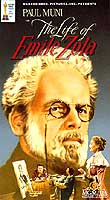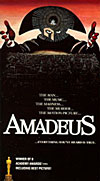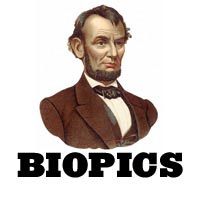 Biopic Films (or biographical pictures)
are a sub-genre of the larger drama and epic film genres, and although they reached
a hey-day of popularity in the 1930s, they are still prominent to this day.
'Biopics' is a term derived from the combination of the words "biography"
and "pictures." These films depict and dramatize the life of an
important historical personage (or group) from the past or present era. Sometimes,
historical biopics stretch the truth and tell a life story with varying degrees
of accuracy. Biopic Films (or biographical pictures)
are a sub-genre of the larger drama and epic film genres, and although they reached
a hey-day of popularity in the 1930s, they are still prominent to this day.
'Biopics' is a term derived from the combination of the words "biography"
and "pictures." These films depict and dramatize the life of an
important historical personage (or group) from the past or present era. Sometimes,
historical biopics stretch the truth and tell a life story with varying degrees
of accuracy.
Big-screen biopics cross many genre types, since these films
might showcase a western outlaw; a criminal; a musical composer; a religious
figure or leader of a movement; a war-time military hero; an entertainer;
an artist; an inventor, scientist, or doctor; a politician or President; a
sports hero or celebrity; or an adventurer.
In many cases, these films put an emphasis on the larger events
(wartime, political or social conditions) surrounding the person's entire
life as they rise to fame and glory. Some begin with the person's childhood,
but others concentrate on adult achievements. Biopics have existed since the
earliest days of silent cinema in films such as French filmmaker Georges Melies'
feature-length epic Jeanne D'Arc (1899) (and Cecil B. DeMille's Joan
the Woman (1916) with opera star Geraldine Farrar), D.W. Griffith's religious
epic Judith of Bethulia (1914), Abel Gance's innovative six-hour-long
epic Napoleon (1927), and director Lloyd Ingraham's Jesse James
(1927) with Fred Thomson as the western outlaw.
According to some sources (although not confirmed),
the most represented
historical character on the screen is French emperor Napoleon Bonaparte.
Others that are very often represented include: US President Abraham
Lincoln, Jesus Christ, Vladymir Ilich Lenin, Adolf Hitler, Cleopatra,
Queen Victoria, Henry VIII, and Queen Elizabeth I. Western characters
often portrayed include William Frederick "Buffalo Bill" Cody,
William Bonney ("Billy the Kid"), Jesse James, Wild Bill
Hickock, General George A. Custer, and Wyatt Earp.
Various actors and actresses have won Academy Award
acting Oscars for their tour-de-force biopic performances, such
as James Cagney as George M. Cohan in Yankee
Doodle Dandy (1942), George C. Scott as the cantakerous WWII
General Patton in the widely-acclaimed Patton
(1970),
Katharine Hepburn as King Henry II's Queen Eleanor of Aquitaine in The
Lion in Winter (1968), Sissy Spacek as legendary country singer
Loretta Lynn in Coal Miner's Daughter (1980), Daniel Day-Lewis
as Irish cerebral palsy victim Christy Brown in My Left Foot (1989),
and Ben Kingsley as the charismatic, pacifist, 20th century Indian
spiritual leader Mahatma in Sir Richard Attenborough's Gandhi
(1982).
Historical Characters in Biopics:
Following the British success of the historical-biographical
film The Private Life of Henry VIII (1933) with Best Actor-winning
Charles Laughton, other studios (both in the UK and in Hollywood) followed
suit with similar treatments of historical characters in the mid- to late
30s:
- Rouben Mamoulian's Queen Christina
(1933)
- John Adolfi's Voltaire (1933)
- Paul Czinner's Catherine the Great (1934)
- Alexander Korda's Rembrandt (1936)
Paul Muni as "Great Men" in Warner Bros. Prestige
Pictures in the 30s:
 In the mid-1930s, three honored Warner Bros. historical/biographical films
(all by director William Dieterle) starred Paul Muni - the archetypal portrayer
of "Great Men" in engrossing character studies: In the mid-1930s, three honored Warner Bros. historical/biographical films
(all by director William Dieterle) starred Paul Muni - the archetypal portrayer
of "Great Men" in engrossing character studies:
- The Story of Louis Pasteur (1936) about the famous
French scientist who attempted to find a cure for anthrax and hydrophobia,
with Muni honored as Best Actor
- the fictionalized Best Picture-winning The Life of
Emile Zola (1937) about the famous French writer and court defender
- Juarez (1939) with Muni as Mexican President Benito
Pablo Juarez opposite Bette Davis as Empress Carlotta von Habsburg
Earlier, Muni was featured as an Al Capone-like gangster in Scarface: The Shame of a Nation (1932), and
in seven different roles in Seven Faces (1929) including Chopin's teacher
Joseph Elsner, Napoleon and Franz Schubert. Later, he portrayed French explorer
Pierre Radisson in Hudson's Bay (1941).
Other examples of historical characters in biographies in
the 1930-40s included Norman Taurog's children's dramatic film Young Tom Edison
(1940) about the famed inventor (Mickey Rooney), The Story of Alexander
Graham Bell (1939), the historical drama Marie Antoinette (1938) about the famous Austrian princess who married future King Louis XVI,
Michael Curtiz' costume drama The Private Lives of Elizabeth and Essex
(1939), and Mervyn LeRoy's oft-nominated Madame Curie (1943) with Greer Garson as the title character researching radioactivity with her husband Pierre (Walter Pidgeon).
Abraham Lincoln and other Political Biopics:
President Abraham Lincoln has often been the primary subject
of biopics, including:
- D. W. Griffith's Abraham Lincoln (1930) with Walter
Huston in the adult title role
- John Ford's quasi-biography Young Mr. Lincoln (1939) with Henry Fonda in the title role
- Raymond Massey in an adaptation of Robert Sherwood's Pulitzer
Prize winning play, Abe Lincoln in Illinois (1940)
- Steven Spielberg's Lincoln (2012), portrayed
convincingly by Best Actor-winning Daniel Day-Lewis
Other presidential, political, and military figures have also
been immortalized in film:
- Henry King's historical/political drama Wilson (1944) told the life story of WWI's US President Woodrow Wilson
- The Desert Fox (1951) was a superb and sympathetic
dramatization/biography of German general Erwin Rommel with James Mason
in the lead role
- the film biography of Franklin Delano Roosevelt's life
was contained in Sunrise at Campobello (1960) with Ralph Bellamy
- David Lean's sweeping spectacular Lawrence of Arabia (1962) provided an intense look at the enigmatic
British leader of the Arab tribes
- Oliver Stone's intense character study Nixon (1995) examined the tragic downfall of Richard M. Nixon with Anthony Hopkins as
the scandalous 37th President of the US and Joan Allen as his supportive,
long-suffering wife Pat
- Alan Parker's musical biography Evita (1996) showcased
Madonna in the role of beloved Argentinian Eva Peron
- Gus Van Sant's Milk (2008) was a biopic of assassinated San Francisco city supervisor and gay-rights-leader Harvey Milk (portrayed by Sean Penn)
- Oliver Stone's satirical W. (2008) - a chronicling of the life of the 43rd President George W. Bush (portrayed by Josh Brolin), a film released during the last few months of W's unpopular tenure
- Michael Sheen and Frank Langella reprised their Broadway roles as British talk-show host David Frost and post-Watergate Richard Nixon from the adaptation of the scintillating Broadway drama about their famous 1977 TV interviews in director Ron Howard's Frost/Nixon (2008); Langella had won the Tony for Best Actor
Artists and Literary Author Biopics:
Although the film traces the career of a fictional newspaper
tycoon (patterned after William Randolph Hearst), Citizen Kane (1941) can be considered a life-story 'biopic.' Artists
and literary authors have also inspired biographical film epics, such as two
films from Vincente Minnelli. His film Madame Bovary (1949) starred
James Mason as Gustave Flaubert on whose classic novel the film was based,
and another film, Lust for Life (1956) featured Kirk Douglas as tormented
Dutch painter Vincent Van Gogh.
Celebrities, Entertainers, Criminals, and Sports Heroes:
 Billy
Wilder's The Spirit of St. Louis (1957) dramatized the historical figure
of 27-year old Charles Lindbergh (James Stewart), the "Lone Eagle."
(See the dramas genre and sports
films sub-genre for biopics such as Knute Rockne,
All-American (1940) and The Pride of the Yankees (1942)). Dustin
Hoffman starred as tormented comedian Lenny Bruce in Lenny (1974),
and Rod Steiger played the title role of Chicago's famous mobster in Al
Capone (1959). Attenborough's reverential Chaplin (1992) chronicled
the life story of silent comedian and film-maker Charlie Chaplin (Robert Downey,
Jr.), as did part of Peter Bogdanovich's The Cat's Meow (2001). And
Tim Burton's zany Ed Wood (1994) was about the maverick, low-budget,
Hollywood director (Johnny Depp) of cult films who often is regarded as the
'worst director' of all time. Milos Forman's Man on the Moon (1999) starred comic Jim Carrey as Andy Kaufman, a quirky and eccentric comedian. Paul Schrader's cautionary Auto Focus (2002) was the quasi-biopic of the double-life of Hogan's Heroes sitcom star Bob Crane (Greg Kinnear), who engaged in various sexcapades due to his newfound fame. Billy
Wilder's The Spirit of St. Louis (1957) dramatized the historical figure
of 27-year old Charles Lindbergh (James Stewart), the "Lone Eagle."
(See the dramas genre and sports
films sub-genre for biopics such as Knute Rockne,
All-American (1940) and The Pride of the Yankees (1942)). Dustin
Hoffman starred as tormented comedian Lenny Bruce in Lenny (1974),
and Rod Steiger played the title role of Chicago's famous mobster in Al
Capone (1959). Attenborough's reverential Chaplin (1992) chronicled
the life story of silent comedian and film-maker Charlie Chaplin (Robert Downey,
Jr.), as did part of Peter Bogdanovich's The Cat's Meow (2001). And
Tim Burton's zany Ed Wood (1994) was about the maverick, low-budget,
Hollywood director (Johnny Depp) of cult films who often is regarded as the
'worst director' of all time. Milos Forman's Man on the Moon (1999) starred comic Jim Carrey as Andy Kaufman, a quirky and eccentric comedian. Paul Schrader's cautionary Auto Focus (2002) was the quasi-biopic of the double-life of Hogan's Heroes sitcom star Bob Crane (Greg Kinnear), who engaged in various sexcapades due to his newfound fame.
Further Examples of Biopics:
Other recent examples of biographical epics in the last few
decades include the following films:
- the multiple award-winning film adaptation of the
musical Broadway hit Amadeus (1984), from director Milos
Forman, viewed the antics of young musical prodigy Mozart (Tom
Hulce) and jealous composer Salieri (F. Murray Abraham)
- Lou Diamond Phillips portrayed the life and career
of Chicano rock 'n' roll star Ritchie Valens in La Bamba (1987),
titled after his 'signature' song
- Bernardo Bertolucci's honored epic of the Chinese Ching
Dynasty and the life of Pu Yi, China's last emperor was the Best Picture-winning The Last Emperor (1987)
- writer/director Spike Lee's epic film Malcolm X (1992) told the life story of the slain civil rights leader with a great performance
from Denzel Washington
- What's Love Got to Do With It (1993) followed
the travails of the song/dance team and couple: Ike (Laurence Fishburne)
and Tina Turner (Angela Bassett)
- Shine (1996, Australia) brought Geoffrey
Rush a Best Actor Oscar for his role as troubled Australian
pianist David Helfgott
- in a breakthrough role, Jennifer Lopez portrayed
Tejano singer Selena Quintanilla-Pérez who was murdered
in 1995 by a jilted ex-president of her fan club, in Selena
(1997)
- Woody Allen's Sweet and Lowdown (1999) - a mock-biography
of a fictional 1930s jazz guitarist named Emmett Ray (portrayed by Sean
Penn)
- two films about the porn film industry and star John C.
Holmes: Boogie Nights (1997) and Wonderland (2003)
- Ron Howard's award-winning A Beautiful Mind (2001) about the life of schizophrenic, Nobel Prize-winning mathematics prodigy
John Forbes Nash, Jr. (Russell Crowe)
- 8 Mile (2002), not technically a biopic -
about hip-hop rapper Eminem (as Jimmy "B-Rabbit" Smith
Jr.) in the mid-1990s in the Detroit area, and
his relationship with Alex (Brittany Murphy)
- British cinema's great comedy actor Peter Sellers who specialized
in multiple roles, portrayed by Geoffrey Rush in HBO Films' production The
Life & Death of Peter Sellers (2004) -- adapted from Roger Lewis'
controversial book of the same name and directed by Stephen Hopkins
- Jamie Foxx as legendary American musician Ray Charles
in director Taylor Hackford's Ray (2004), a biographical
drama about the legendary figure's career and life's problems
with women and drug addiction [the film was released only months
after Charles' death in 2004]
- Bill Condon's biopic of controversial human sexuality researcher Kinsey (2004) (its tagline: "Let's talk about sex"), with
Liam Neeson as the title character and Laura Linney as his wife, stirred
up further protest about the impact of his pioneering work, interviews and
publications on morality and behavior
- Leonardo DiCaprio in Martin Scorsese's biopic The Aviator
(2004) as the central character - the eccentric and high-flying Howard
Hughes - over three decades
- James Mangold's biopic Walk the Line (2005),
about the early life and career of country music artist Johnny
Cash (Joaquin Phoenix) and his romance with long-suffering June
Carter (Oscar-winnng Reese Witherspoon)
- Rob Cohen's King of the Nudies (2009), a biography on sexploitation filmmaker and adult film pioneer Russ Meyer (dubbed "King Leer"), based on the book of the same name
- Notorious (2009) was the life-story of Christopher
Wallace - aka The Notorious B.I.G. or Biggie Smalls (played by
Jamal Woolard), who was tragically shot to death at the age of
24 during a drive-by shooting
|
